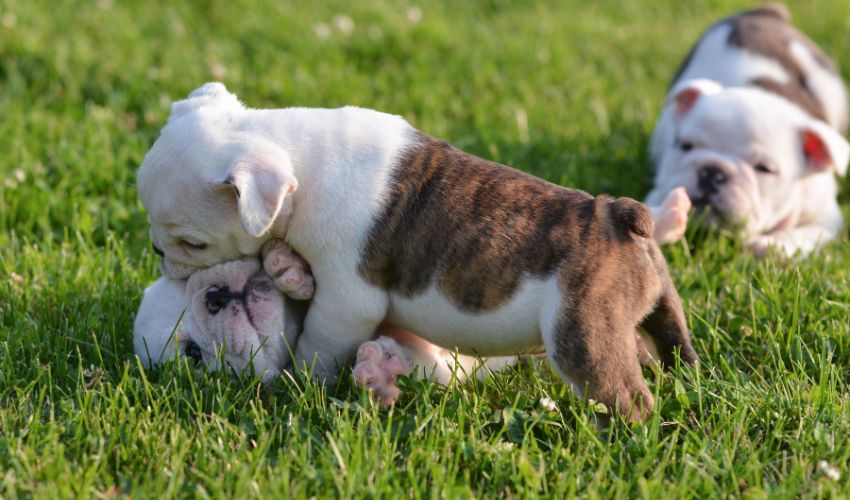As a dog lover and potential breeder, one of the questions that may have crossed your mind is, “Is it common to lose puppies in a litter?”
The answer may not be as straightforward as you think.
While it is natural for some puppies not to survive in a litter, the frequency and causes of puppy loss can vary.
In this article, we will delve into the factors that contribute to puppy loss.
- The statistics and studies on the frequency of puppy loss
- Common causes of puppy loss.
- Signs of potential problems.
- Preventive measures.
- When to seek veterinary assistance.
- Coping with loss.
- Support for breeders dealing with puppy loss.
Table of Contents
ToggleIs It Common To Lose Puppies In A Litter?
Common puppy mortality rates are between 20-30%, which include stillborn puppies.
Approximately half of these losses occur within the first week after birth, with the other half occurring up to 8 weeks old.
However, this rate can vary depending on the breed, health of the parents, and other factors.
Some breeds may have a higher mortality rate, while others may have a lower rate.
While the loss of puppies in a litter can be heartbreaking, it is important to understand that it is not uncommon.
It is also worth noting that the majority of puppy loss occurs within the first few weeks of life.
This is when the puppies are most vulnerable and dependent on their mother for warmth, nutrition, and protection.
As they grow older and stronger, their chances of survival increase.
However, it is essential to monitor the litter closely during this critical period and take necessary precautions to ensure their well-being.
Factors Influencing Puppy Mortality
There are several factors that can contribute to the mortality of puppies.
One significant factor is genetics.
Certain breeds may be more susceptible to certain health conditions or have a higher overall mortality rate.
Genetic testing and screening can help identify any potential health risks in specific breeds, allowing breeders and owners to make informed decisions regarding breeding and healthcare.
The health of the mother dog also plays a crucial role in puppy mortality rates.
A healthy and well-cared-for mother dog is more likely to produce healthy puppies.
Regular veterinary check-ups, vaccinations, and a balanced diet can help ensure the mother dog’s overall well-being, which in turn can positively impact the survival chances of her puppies.
Additionally, the mother dog’s ability to provide care and nourishment to her puppies can greatly impact their chances of survival.
Adequate milk production and the mother’s instinct to nurse and care for her puppies are essential for their growth and development.
In cases where the mother dog is unable to provide sufficient care, supplemental feeding and intervention from a veterinarian may be necessary to improve the puppies’ chances of survival.

Breed-Specific Puppy Mortality Rates
You may also be wondering if it is common to lose puppies in a litter of certain breeds.
It’s important to note that different breeds may have varying mortality rates among their puppies.
Some breeds may be more predisposed to certain genetic conditions or have specific birthing challenges that increase the risk of mortality.
For example, brachycephalic breeds, such as Bulldogs and Pugs, are known to have higher rates of puppy mortality due to their unique anatomy and respiratory issues.
If you are considering breeding your dog or are in the process of adopting a puppy, it can be helpful to research the specific breed’s mortality rates to ensure you are well-prepared and proactive in caring for your new furry family member.
Understanding the breed-specific risks and taking appropriate measures can help minimize the chances of puppy mortality and promote a healthier and happier life for your canine companion.
Common Causes Of Puppy Death
Understanding the common causes of puppy loss can help breeders take proactive measures to prevent or minimize the risk.
Common causes of puppy death include:
- Poor nutrition
- Diseases
- Congenital abnormalities
- Trauma
- Complications at birth
One of the leading causes of puppy loss is inadequate nutrition.
If the mother dog is not receiving a balanced diet during pregnancy or lactation, it can negatively impact the health of the puppies.
Providing a high-quality diet and appropriate supplements can help ensure the mother’s nutritional needs are met, resulting in healthier puppies.
Infectious diseases, such as parvovirus and canine herpesvirus, can also be a significant cause of puppy loss.
These diseases can be transmitted from the mother dog to her puppies, leading to severe illness and even death.
Vaccinating the mother dog before breeding and keeping her up to date with vaccinations can help reduce the risk of infectious diseases.
Some puppies may be born with congenital abnormalities that are incompatible with life or make them more susceptible to health problems.
Ensuring a safe and stress-free birthing environment, as well as regular prenatal check-ups, can help identify any potential issues early on and take appropriate actions.
Recognizing Signs Of Potential Problems In A Litter
Being able to recognize early signs of potential problems in a litter is crucial in ensuring the well-being of the puppies.
One of the first signs to be aware of is a decrease in appetite or weight loss in the mother dog.
If she shows a lack of interest in food or experiences significant weight loss, it may indicate a problem with the litter.
Other signs include abnormal discharge from the mother’s vulva, excessive crying or restlessness in the puppies, and failure to thrive.
Monitoring the puppies’ growth and development is also important.
If any puppy consistently lags behind in size or fails to reach developmental milestones, it may signal an underlying health issue.
Additionally, observing the behavior of the mother dog is essential.
If she is neglecting or showing aggression towards her puppies, it may be an indication of stress or illness.
Promptly addressing any signs of potential problems can help prevent further complications and increase the chances of a successful outcome.
Regular veterinary check-ups and open communication with your veterinarian are essential for ensuring the health and well-being of the mother dog and her puppies throughout the pregnancy.
Preventive Measures To Minimize Puppy Loss In A Litter
While some puppy loss may be unavoidable, there are preventive measures breeders can take to minimize the risk.
First and foremost, ensuring the health of the parents before breeding is essential.
Conducting thorough health screenings and genetic testing can help identify any potential issues that may affect the litter.
Breeding only from healthy and genetically sound individuals can significantly reduce the chances of losing puppies.
Maintaining a clean and stress-free environment for the mother dog and her puppies is also crucial.
Regularly disinfecting the whelping area, providing proper bedding, and minimizing exposure to potential pathogens can help prevent infections and diseases.
Additionally, providing a balanced diet and appropriate supplements to the mother dog can ensure she has the necessary nutrients for a healthy pregnancy and lactation.
Regular veterinary check-ups throughout the pregnancy and after the birth of the litter are vital.
The veterinarian can monitor the mother’s health and provide guidance on nutrition, vaccinations, and general care.
They can also conduct regular examinations of the puppies to ensure they are growing and developing as expected.
Early detection of any issues can lead to timely interventions and a higher chance of successful outcomes.

Environmental Factors Affecting Puppy Survival
While genetics and maternal care are key contributors to puppy survival, the environment in which they are raised can also significantly impact their well-being.
It is important to consider various factors that can affect their health and overall development.
The Impact of Living Conditions on Puppy Health
The quality of the living conditions can make a substantial difference in the survival and development of puppies.
Clean, sanitary surroundings with adequate space and proper temperature regulation are essential.
Puppies need a safe and comfortable space to grow and thrive.
Providing a clean environment is crucial to prevent the spread of diseases and infections.
Regular cleaning and disinfection of the living area can help eliminate potential health risks.
Additionally, ensuring that the puppies have enough space to move around and play is important for their physical and mental well-being.
Furthermore, the availability of proper nutrition and fresh water is essential for their growth and development.
Puppies should have access to a balanced diet that meets their nutritional needs.
Adequate hydration is also crucial to prevent dehydration, especially during hot weather.
Reducing exposure to potential hazards is another important aspect of creating a safe living environment for puppies.
Keeping toxic substances, such as cleaning products and chemicals, out of their reach can prevent accidental poisoning.
Additionally, removing any small objects or choking hazards from their surroundings can help prevent accidents.
Providing a stimulating environment is also beneficial for the puppies’ well-being.
Offering toys and interactive activities can help keep them mentally engaged and prevent boredom.
This can contribute to their overall happiness and reduce the risk of behavioral issues.
The Role of Temperature and Humidity in Puppy Survival
Puppies are particularly sensitive to temperature and humidity levels.
Extreme heat or cold can endanger their lives.
Ensuring a controlled and comfortable environment is crucial, especially during their early weeks of life.
During cold weather, providing adequate heating solutions is essential to keep the puppies warm.
This can include using heat lamps, heating pads, or providing a warm and insulated shelter.
It is important to monitor the temperature regularly to prevent overheating or chilling.
In hot weather, it is crucial to keep the puppies cool and prevent heatstroke.
Providing shade and proper ventilation in their living area is important.
Additionally, offering access to fresh water at all times is essential to prevent dehydration.
Monitoring humidity levels is also important, as high humidity can contribute to discomfort and respiratory issues.
Using dehumidifiers or ensuring proper ventilation can help maintain a suitable humidity level for the puppies.
Overall, creating a safe and comfortable environment for puppies is crucial for their survival and well-being.
By considering factors such as living conditions, temperature, and humidity, we can help ensure that they have the best possible start in life.

When To Seek Veterinary Assistance For A Litter
In some cases, despite taking preventive measures, a breeder may still encounter difficulties with a litter.
Knowing when to seek veterinary assistance is crucial in ensuring the best possible outcome for both the mother dog and her puppies.
If the mother dog is showing signs of distress, such as prolonged labor, excessive bleeding, or difficulty delivering a puppy, immediate veterinary attention is necessary.
These signs may indicate a complication during the birthing process that requires medical intervention.
Similarly, if any of the puppies show signs of illness, such as lethargy, loss of appetite, diarrhea, or difficulty breathing, veterinary assistance should be sought without delay.
Prompt diagnosis and treatment can greatly improve the chances of survival for the affected puppies.
Additionally, if there is a sudden increase in puppy loss or multiple puppies are failing to thrive, consulting with a veterinarian can help identify any underlying issues and determine appropriate action.
Remember, it is always better to err on the side of caution when it comes to the health and well-being of the mother dog and her puppies.
Veterinarians are trained professionals who can provide guidance, support, and medical care to ensure the best possible outcome for all involved.
Coping With The Loss Of Puppies In A Litter
Losing puppies in a litter can be an emotionally challenging experience for breeders.
It is important to allow yourself time to grieve and process the loss.
Reach out to fellow breeders or support groups who have experienced similar situations.
Sharing your feelings and experiences with others who can empathize can provide comfort and validation.
It is also crucial to remember that not all losses are preventable.
Sometimes, despite our best efforts, nature takes its course.
Be kind to yourself and acknowledge that you did everything within your power to provide the best care for the mother dog and her puppies.
Focus on the puppies that did survive and ensure their continued health and well-being.
Support And Resources For Breeders Dealing With Puppy Loss
If you are a breeder who is dealing with the loss of puppies, know that you are not alone.
There are numerous support groups, online communities, and resources available to help you through this difficult time.
Connecting with others who have gone through similar experiences can provide valuable insight and emotional support.
Many veterinary clinics and animal welfare organizations offer counseling services or can recommend professional counselors who specialize in pet loss.
Seeking professional help can be beneficial in coping with the grief and navigating the complex emotions associated with losing puppies.
Conclusion: Understanding The Odds And Taking Proactive Measures
Losing puppies in a litter is not uncommon, but it is a heartbreaking experience for breeders.
By understanding the factors that contribute to puppy loss, recognizing signs of potential problems, and taking preventive measures, breeders can minimize the risk and increase the chances of a successful outcome.
It is important to seek veterinary assistance when necessary and to remember to take care of your emotional well-being when coping with the loss of puppies.
Remember, you are not alone, and there are support and resources available to help you through this challenging time.
Frequently Asked Questions:
Is It Common For A Puppy to Die In A Litter?
Typical puppy mortality rates range from 20% to 30%, including stillborn puppies.
Roughly half of these losses occur within the initial week after birth, with the rest occurring up to 8 weeks old.
These rates can fluctuate based on factors such as breed, parental health, and other variables.
What Is The Most Common Reason Puppies Die?
Puppies most commonly die from poor nutrition. Other causes include:
- Diseases
- Congenital abnormalities
- Trauma
- Complications at birth
Do Dogs Get Depressed After Losing A Puppy?
Yes, dogs can experience a form of grief or sadness after losing a puppy.
While not the same as human depression, dogs may exhibit behavioral changes, decreased energy, or signs of distress.
Providing support, attention, and time for grieving can help alleviate their emotional response.
